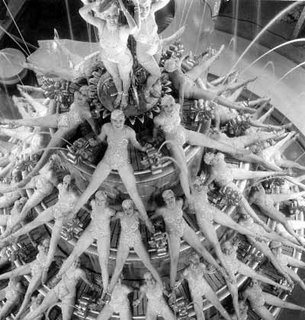Busby

Busby Berkeley -- born William Berkeley Enos on this day in 1895 in Los Angeles -- grew up in the theater: his parents were performers in a traveling repertory company, and Berkeley was nicknamed "Busby" after stage actress Amy Busby, one of the stars of his parents' troupe. Berkeley's parents shipped him off to a military academy and by 1914 Berkeley was a management trainee at a Massachusetts shoe factory.
In 1917, he enlisted in the U.S. Army and served in France during World War I, where he had his first experiences in conducting large numbers of people through complex marching patterns as a field artillery lieutenant, working out a trick drill for 1,200 men.
Returning to the states, he entered the theater as an actor, significantly in the role of fashion designer "Madame Lucy" in a Broadway revival of Irene (1923-26). Soon, however, he was serving as dance director for Broadway productions, despite the fact that he had never taken a dancing lesson in his life, bluffing his way through choreography sessions by getting his dancers to demonstrate what he had in mind. By 1930, he was one of the most sought after dance directors on Broadway with a reputation for devising intricate dance spectacles involving staircases and multi-layered platforms.
He went to Hollywood in 1930 to direct dance numbers for an Eddie Cantor vehicle, Whoopee, in which Berkeley stretched the envelope of static early sound film technique, forcing his director to enter the realm of pure cinema by lifting the camera above the soundstage to see Berkeley's dancers form geometric patterns. In 42nd Street (with Ruby Keeler and Dick Powell) and Footlight Parade (with Keeler, Powell and James Cagney) (both 1933; directed by Lloyd Bacon) and in later Warner Brothers musicals, Berkeley emerged as a true screen original, choreographing elaborate dance numbers involving hundreds of dancers moving in syncopated precision on oversized sets, through waterfalls and giant swimming pools, and on winding staircases and aerial platforms -- or as described by one film critic: "kaleidoscopic patterns of female flesh, dissolving into artichokes, exploding stars, snowflakes and the expanding leaves of water lillies."
His interest in using the camera and editing in inventive ways to highlight his production numbers led him to try directing, which he did successfully in a variety of musicals, including Babes in Arms (1939; with Mickey Rooney and Judy Garland) and The Gang's All Here (1943; with Alice Faye and Carmen Miranda).
Among the stars who got their start as Berkeley dancers were Lucille Ball, Paulette Goddard and Betty Grable. As musicals fell out of favor in the late 1950s, however, so did Berkeley, but his reputation re-emerged in the 1970s as Berkeley's work became celebrated as one of the essential liberating influences of 1930s cinema. Berkeley died on March 14, 1976.
Labels: Classic Cinema, Theater





0 Comments:
Post a Comment
Subscribe to Post Comments [Atom]
<< Home